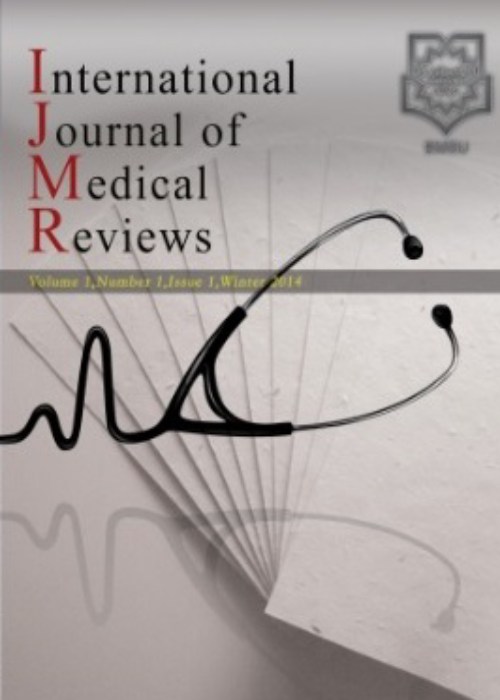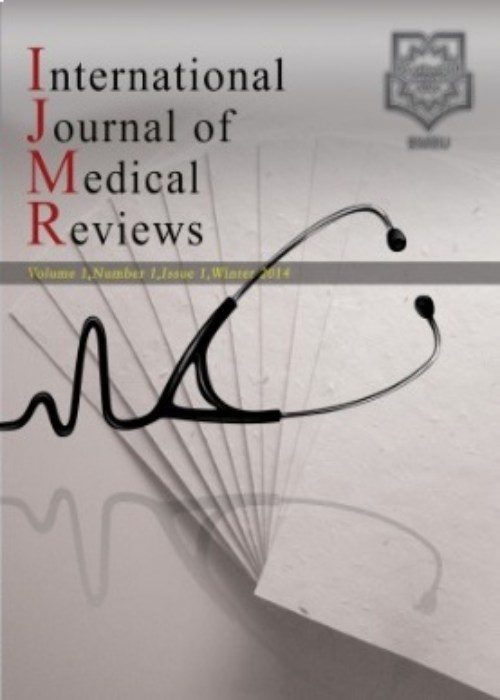فهرست مطالب

International Journal of Medical Reviews
Volume:9 Issue: 4, Autumn 2022
- تاریخ انتشار: 1401/11/05
- تعداد عناوین: 6
-
-
Pages 361-368Introduction
Keratinocyte carcinomas are the most common malignant conditions in Caucasian populations. African albinos have hypomelanized sensitive skin that is quite susceptible to photo carcinogenesis. Of the keratinocyte carcinomas, Squamous Cell Carcinoma (SCC) has been found more frequent in pigmented Africans, while Basal Cell Carcinoma (BCC) predominates in Caucasians. The aim of the present study was to estimate the prevalence of cutaneous SCC and BCC in all histologically confirmed skin cancer lesions in African albinos.Data Source: Five databases: African journals on line (AJOL), PUBMED, Europe PMC, Google scholar, and Cochrane librarywere searched for relevant articles.
Study Selection:
Included studies were case series and cross sectional studies of histologically confirmed skin cancers in African albinos. Data extraction and synthesis was informed by Meta-analysis of Observational Studies in Epidemiology Guideline. By random effect meta-analysis, we calculated the pooled prevalence of SCC and BCC in skin cancer lesions of the African albino.
ResultsWe abstracted 695 skin cancer lesions from 540 African albinos (275 male and 241 female albinos with sex not stated in 24 subjects). There were 419 SCCs and 249 BCCs. By meta-analysis, the pooled prevalence of SCC was 64% (95% CI: 50- 77%). In addition, the prevalence for BCC was 31% (95% CI: 19-45%).
ConclusionSquamous cell carcinoma is the predominant type of keratinocyte carcinoma reported in African albinos.
Keywords: Keratinocyte Carcinoma, African Albino, Squamous Cell Carcinoma, Basal cell carcinoma, Skin Cancer -
Pages 369-388Introduction
As previous pandemics, the COVID-19 outbreak has been inflicting different mental disorders upon people. Such significant effects have led to a novel psychological pandemic that makes the COVID-19 pandemic management more difficult. The objective of this systematic review was to explore the global view of the psychological impact of the COVID-19 pandemic in its earlier stage.
MethodsA systematic search of PubMed, EMBASE, and Google Scholar databases was performed up to June 20th, 2020. Fulltext articles were evaluated by three authors regarding predefined criteria. A modified version of the Newcastle-Ottawa Scale for observational studies was used to assess the risk of bias. The review protocol is registered and available online in PROSPERO.
ResultsOverall, the analysis from this review suggested that there is a lack of sufficient robust evidence to confirm theassociation between the COVID-19 pandemic and mental impact. However, most of the studies pleaded for the assumption that the pandemic affected the mental health of the population throughout the world.
ConclusionGovernments and decision-makers are required to respond promptly to any eventual outbreak to ensure thepopulation's mental health well-being through some strategic planning and prevention.
Keywords: Systematic review, COVID-19, mental health, Psychological Impact, psychological symptoms -
Pages 389-396
Saliva is a complex fluid produced by the salivary glands. It is the secretion of the salivary glands and constitutes one of the largest secretions of the human body. It maintains the integrity of both the soft and hard tissues of the mouth and it constitutes one of the main natural defence systems of the oral cavity. Saliva consists of varied organic and inorganic components and its secretion is influenced by sympathetic and parasympathetic stimulation. Saliva also contains hormones, antibodies, growth factors, enzymes, microbes and their products. Many of these constituents enter saliva through blood via passive diffusion, active transport or extracellular ultrafiltration. Therefore, saliva can be seen in many cases as a reflection of the physiological function of the body. It is actually a clinically informative, biological fluid (biofluid) that is useful for novel approaches to prognosis, laboratory or clinical diagnosis, and monitoring and management of patients with both oral and systemic diseases. This review article aims to elaborate and discuss about the enzymes in saliva. There are about 25 to 30 enzymes found in saliva after reviewing the literature to best of our knowledge. Newer advancements and technologies have enabled saliva to be used as a diagnostic biomarker. We also enumerated a list of enzymes present in saliva and its function as a short review for the first time in the literature here, thereby contributing our work to researchers to gain knowledge and encourage them to carry out further studies in the field of salivary enzymes
Keywords: Saliva, Enzymes, Biomarkers, Diagnosis, Prognosis -
Pages 397-405
A thrombotic complication is one of the severe clinical outcomes of COVID-19. Various pathophysiological mechanisms for thrombotic events in COVID-19 have been proposed. Consistently, elevated D-dimer level has emerged as an independent risk factor for poor outcomes, including death. Several other laboratory markers and blood counts have also been associated with poor prognosis, possibly due to their relation with thrombosis. At present, the pathophysiology underlying the hypercoagulable state is poorly understood. As a result, most critically diseased COVID-19 patients are managed with prophylactic anticoagulant. The management of COVID-19 was based generally on supportive therapy and treatment that prevent respiratory failure since it's directly effects on human respiratory system. However, antiviral now and other medications alongside vaccination are used. Vaccination also found to cause thrombosis symptoms are in many COVID-19 recipients. Vaccine-induced immune thrombotic thrombocytopenia was clearly recorded with significant and awful outcomes. No clear cause for this syndrome, but many hypotheses have been established to explain the mechanism of thrombosis formation. An interaction between platelets or platelet factor 4 with anti-PF4 is a similar point in the pathogenesis of problem. Since covid19 and its vaccine induce hypercoagulability condition, it was found that anticoagulation therapy may block or slow progression of thrombosis formation.Treatment of COVID-19 vaccines-induced hypercoagulation include many intents; as anti-inflammatory, antithrombotic and antiviral drug. This can be done by one drug like low dose aspirin or more as warfarin that use as anticoagulant. Direct oral anticoagulant can also be used. Sometimes, combination of low dose aspirin and clopidogrel may be given as they are very effective. Focusing on treatment of thrombosis in COVID-19 has increased lately, consequently, many drugs like dipyridamole, (which is significantly improved platelet and lymphocytes count and decrease D-dimer level) become use for patient and more studies about its effect are done to reach a very effective treatment.
Keywords: Anticoagulant, Antiplatelet, COVID-19, Hypercoagulability, Thrombosis, Vaccine -
Pages 406-413IntroductionHypertension is the most important disease that can cause heart failure, renal dysfunction, stroke and sodden death in a large population throughout the world. The excessive side effects of the chemical drugs that are used in the treatment of hypertension have attracted attention to herbal medicine.MethodsThis study was designed as a randomized clinical trial on both males and females with first and second stage of hypertension. The patients who met inclusion criteria and none of the exclusion criteria were enrolled in the study. The patients were allocated with random blocked dividing between the case and control group with the same group size. The patients in the control group used placebo and patients in case group used mixed therapeutic syrup of Ziziphus Jujube and Thymus daenensis Celak. The syrup was used twice a day with a dose of 5 ml for each time. In order to study the effects of Ziziphus and Thymus on blood biomarkers, it was checked in two stages.ResultsFindings reveal that the mixture of herbal syrup could significantly reduce Systolic Blood Pressure (SBP) and Diastolic Blood Pressure (DBP) in hypertensive patients (p = 0.002). The reduction in SBP and DBP at the end of the study was 11.84 and 8.03 mmHg, respectively. Also, the mean arterial pressure compared to the baseline decreased to 8.35%. Regards to other parameters, the results of the experiments at the beginning and end of the study showed that Complete Blood Count (CBC), Fasting Blood Sugar (FBS), cholesterol, low-Density Lipoproteins (LDL), High-Density Lipoprotein (HDL), Aspartate Aminotransferase (AST), Alanine Transaminase (ALT), Alkaline Phosphatase (ALP), Blood Urea Nitrogen (BUN), and creatinine were in the normal laboratory range.ConclusionAccording to results it can be stated that jujube and thyme can be considered as a miraculous combination in Cardiovascular Disease, Persian Traditional Medicine, Blood Pressure, Thymus Daenensis, Ziziphus Jjujube controlling blood pressure, to minimize secondary complications caused by hypertension.Keywords: Cardiovascular disease, Persian traditional medicine, blood pressure, Thymus daenensis, Ziziphus jujube
-
Pages 414-418
Schwannoma’s are benign tumors that can affect all nerves even the peripheric nerve. In the present study, a 66 year old case (man) which had a mass upon his wrist with a diagnostic delay of two years has been studied. Diagnosis was based on imaging features (Ultrasonography and MRI) with Electromyography (EMG) which was assessed by histopathological examination.
Keywords: schwannoma, Wrist, Median Nerve, MRI


